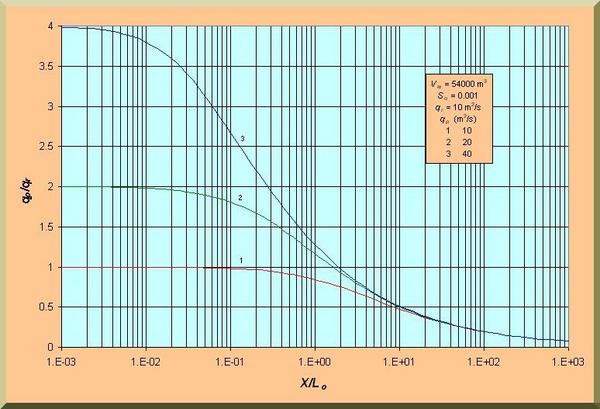 online_dimensionless_dam_breach_analysis
online_dimensionless_dam_breach_analysis

|
|
DESCRIPTION
[Example]
[Reference]
[Main Page]
A dam-breach flood wave propagates along a river reach with velocity and depth usually decreasing with time and distance. Forecasting dam-breach flood waves has received considerable attention in the literature. The breach-outflow hydrograph is a function of the geometric and hydraulic properties of the reservoir and the geometric dimensions and geotechnical properties of the embankment. Its determination is usually subject to great uncertainty. From a practical standpoint, given a feasible range of breach-outflow hydrographs at a damsite, there is a need to evaluate the propagation of these possible flood waves. For any given reservoir, the breach outflow hydrograph peak discharge is inversely related to the flood duration and, by extension, to the time-of-rise of the hydrograph. Since the amount of flood wave attenuation is inversely related to the time-of-rise, it follows that several postulated breach-outflow hydrographs may eventually attenuate to about the same peak discharge. This later value is referred to as ultimate discharge, and the distance where it occurs along the downstream channel as the ultimate distance. This online calculator computes both "ultimate" values.
The input is: At the dam: Peak discharge Qp (m3/s) Released reservoir volume Vr (m3) Effective breach width Wb (m) Along the downstream channel: Average channel flow top width To (m) Average channel bed slope So (m/m) Average value of Manning's n The output is: Ultimate downstream distance Xu (m). Ultimate downstream distance Xu (km). Ultimate peak unit-width discharge qpu at distance Xu (m2/s) Ultimate peak discharge Qpu at distance Xu (m3/s)
Following the reference paper, the ratio of input variables Vr /Wb (released reservoir volume per unit of breach width) is limited between the values of 27,000 m2 (small) and 108,000 m2 (large). Likewise, the value of input variable bed slope So is limited between the values of 0.01 (steep) and 0.0001 (mild). Given a postulated earth dam breach failure, the calculator will compute the distance along the downstream channel after which the peak discharge is likely to remain the same, independently of the breach peak discharge. In practice, this information may prove valuable in assessing the need for emergency preparedness in the event of a postulated earth dam breach failure. Input/output analysis
This calculator provides an estimate of the ultimate distance and ultimate
discharge along the downstream channel, following a postulated earth dam breach failure.
A default Manning's n = 0.05 is provided, considered to represent a typical field condition. The calculator provides lumped-parameter estimates, useful for a preliminary appraisal of the flooding risks associated with a postulated earth dam breach failure. |